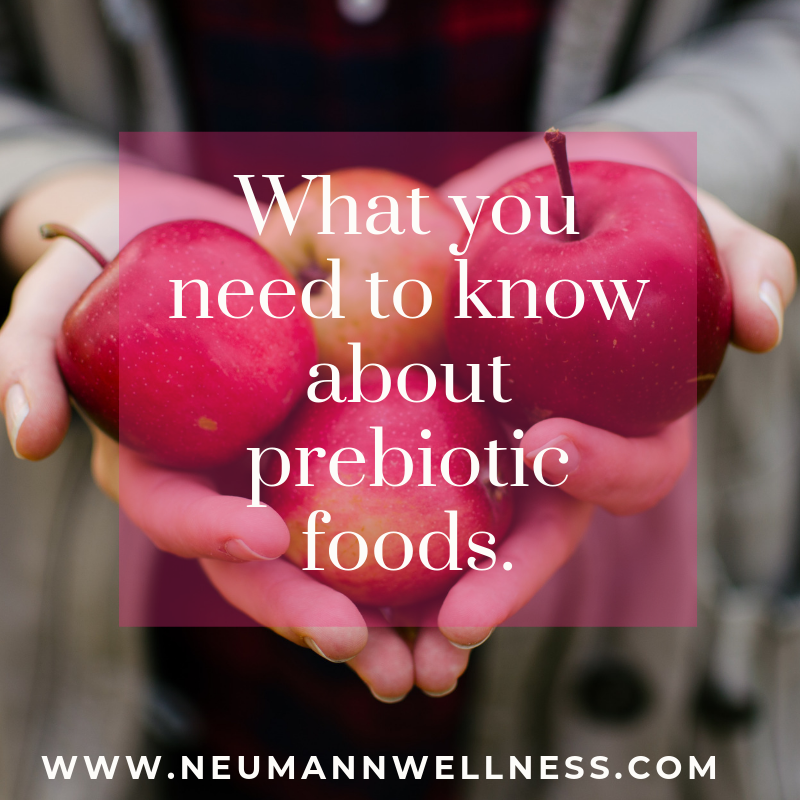
Unlock the Amazing Health Benefits of Prebiotics
Picture a life where gut issues like bloating, constipation, and indigestion are a thing of the past. Prebiotics are the powerful, often overlooked heroes that restore balance to your gut, transforming your digestive system into a well-functioning powerhouse.
By fueling beneficial bacteria, prebiotics not only relieve common digestive problems but also boost your overall health in remarkable ways. They promote clearer skin by reducing inflammation and wrinkles, support weight management by regulating hunger and metabolism, and even enhance mental clarity by improving gut-brain communication.
With prebiotics on your side, you’re not just improving digestion—you’re unlocking a whole new level of vitality.
In this comprehensive blog post I’ll cover all you need to know on the topic of prebiotics, including:
- What are prebiotics and why they’re so important
- Health benefits of prebiotics
- The different types of prebiotics you need to know
- How much prebiotic is ideal for your gut?
- How to naturally boost prebiotic-like foods in your diet
- 20 delicious prebiotic and probiotic meals & snack ideas to kick start your gut health
- My top 3 favorite prebiotic supplements for maximum results
The Power of Your Gut: Why It’s the Key to Your Health
Your gut microbiome impacts everything—your digestion, immune system, mood, skin, and hormones.
When it’s out of balance, you’re at risk for issues like Irritable Bowel Syndrome (IBS), Irritable Bowel Disease (IBD), autoimmune disorders, mental health struggles, obesity, eczema, and more.
If you’re dealing with any of these problems, it’s time to focus on restoring your gut health. One of the most effective ways to do that? Adding prebiotic-rich foods to your diet.
The Secret Power of Prebiotics: Why They’re Just as Important as Probiotics
You’ve probably heard a lot about probiotics—the beneficial bacteria found in fermented foods and supplements that help keep your gut balanced.
But here’s the thing: prebiotics are just as crucial! These fiber-rich foods feed the good bacteria in your gut, helping them thrive and do their job.
By fueling your probiotics with prebiotics, you’re boosting the growth of healthy microbes that make you healthier overall.
Prebiotic Supplements vs. Prebiotic Foods: What’s the Difference?
Let’s break it down simply: prebiotics are the fiber-rich foods that “feed” the good bacteria in your gut. Whether you get them from foods or supplements, they help keep your gut healthy and balanced. But there’s a key difference in how you get them:
Prebiotic Foods are natural sources of prebiotics, like fruits, veggies, whole grains, and legumes. These foods are packed with fiber that your gut bacteria love to feed on. When you eat these foods, your body gets the benefits of both the fiber and all the extra vitamins, minerals, and antioxidants that come along with them. It’s a whole food approach to gut health.
Prebiotic Supplements, on the other hand, are concentrated forms of prebiotics in pill or powder form. They provide a direct, measured dose of prebiotics without all the extra nutrients that come with whole foods. These can be convenient if you have a hard time getting enough prebiotics from your diet or need a concentrated dosage.
In short: Prebiotic foods give you a healthy gut boost and a full range of nutrients, while prebiotic supplements are a quick, targeted dose to give your gut what it needs. Both are useful.
Remember: Not All Fiber Is Prebiotic. For a Food to Truly Be Classified as Prebiotic, It Has to Meet Certain Criteria:
- It must pass through the stomach and small intestine without being broken down or absorbed
- It acts as a targeted fuel for specific beneficial bacteria in the large intestine
- It helps shift your gut microbiota toward a healthier, more balanced state
- And it triggers positive, far-reaching changes in your overall health
The Power of Prebiotics: Why Your Gut Needs Them
Let’s talk about some serious benefits of prebiotics—those fiber-packed foods that fuel your gut’s good bacteria. You’ve probably heard of Bifidobacteria and Lactobacilli, the heavy hitters in your gut microbiome. Well, prebiotics help these beneficial bacteria thrive, and when they do, they work their magic.
Here’s just a taste of what they do for you:
- Short Chain Fatty Acids (SCFAs): These powerful metabolites are produced by your gut bacteria when they digest prebiotics. SCFAs have a ton of health benefits, including feeding the cells of your gut lining and boosting your gut barrier function.
- Less Protein Fermentation: Prebiotics reduce the fermentation of protein in your gut, which means fewer toxic by-products that could contribute to digestive distress or disease.
- Fewer Bad Bacteria: By nourishing the good bacteria, prebiotics help keep the bad guys in check, reducing the populations of harmful, pathogenic bacteria.
- Allergy Protection: Yep, prebiotics can actually help reduce your risk of allergies. Who knew your gut health could be this proactive?
- Gut Barrier Boost: A stronger gut barrier means better defense against harmful invaders, reducing leaky gut and related issues.
- Immune System Power-Up: With a balanced gut, your immune system gets a solid boost, making you less vulnerable to infections.
- Less Diarrhea from Antibiotics: Prebiotics help reduce the duration of antibiotic-associated diarrhea, making recovery smoother after necessary meds.
- Better Mineral Absorption: They also improve your body’s ability to absorb key minerals like calcium, magnesium, and iron, which are essential for your bones, muscles, and overall health.
- Appetite Control & Weight Loss: Prebiotics can promote feelings of fullness, helping you manage your weight naturally and comfortably.
- Reduced Inflammation: They play a role in lowering inflammation, especially important for those suffering from inflammatory bowel diseases like Crohn’s or ulcerative colitis.
- Cancer Protection: Studies even suggest that prebiotics may offer protective effects against colon cancer.
I don’t know about you, but all these benefits seem like a solid reason to load up on prebiotic-rich foods, right? Your gut (and your whole body) will thank you!
Harnessing the Power of Prebiotics: The Types You Need to Know
Alright, let’s get into the nitty-gritty of prebiotics. Not all fiber is created equal, and only certain fibers have the superpowers to feed your gut’s good bacteria.
Here’s a breakdown of the different types of prebiotics, each one packing a punch for your gut health:
- Oligosaccharides: These are short chains of sugar molecules that act as fuel for your gut bacteria. Some common types include:
- FOS (Fructooligosaccharides): Found in bananas, onions, garlic, asparagus, leeks, chicory root, burdock, and Jerusalem artichoke. FOS is also commercially made from sucrose and can be found in supplements and functional foods. This prebiotic is excellent for boosting Bifidobacteria.
- GOS (Galactooligosaccharides): Found in beans, lentils, and Jerusalem artichoke, and made commercially from lactose. GOS is a favorite of Lactobacilli bacteria and supports your gut’s balance.
- Inulin: This one is a superstar in the prebiotic world. Found in foods like wheat, onions, bananas, garlic, asparagus, and Jerusalem artichoke, inulin helps with calcium absorption and boosts your immune system. It’s also commercially extracted from chicory root for use in foods and supplements. Bonus: inulin is known for supporting your gut’s ability to absorb key minerals like magnesium and iron.
- Gums and Mucilages: These are natural substances that form a gel-like consistency when hydrated and are great at soothing the gut. You’ll find these in:
- Guar gum, gum arabic, and acacia gum (often used as thickeners in foods and supplements)
- Other Non-Starch Polysaccharides: These are complex carbohydrates that aren’t digested by your body but are a feast for your gut bacteria.
- Pectin: Found in fruits like apples, pears, and citrus, pectin promotes gut health by feeding good bacteria and regulating digestion.
- Beta-glucan: A powerhouse prebiotic found in oats, barley, and mushrooms. Beta-glucan has been shown to lower cholesterol, support immune function, and help manage blood sugar levels.
Each of these prebiotic types plays a unique role in your gut health, feeding your beneficial bacteria, boosting immunity, and keeping your digestive system running smoothly. So, if you want to get the best out of your gut, make sure you’re loading up on a variety of these fiber-rich foods! Your gut—and your whole body—will thank you.
How Much Prebiotic Do You Need?
Prebiotics have been a part of our diet for centuries, with ancient hunter-gatherers eating up to 135g of inulin daily. Today, most Americans get just 2-8g. That’s a huge difference!
The decline in prebiotic intake is likely due to the rise of refined foods in our modern diets. While you don’t need to go back to 135g of inulin (that’d be tough to digest!), it’s essential to start adding more prebiotic fibers to your daily routine.
Although the exact ideal amount is still unclear, experts suggest aiming for 5g-20g of prebiotic fiber daily.
The key is to start slow, especially if your diet is already low in fiber. If you’re following a low FODMAP diet or keto diet, you’re missing out on these gut-friendly fibers—something to think about for your gut health!
So, aim for at least 5g of prebiotics per day, and consider gradually increasing it from there!
How to Get Prebiotics Naturally from Your Diet
Now that you know the scoop on prebiotics and how much you should aim for, let’s get to the fun part—what to eat! To really fuel your gut, you’ll want to include these top 10 gluten-free prebiotic-rich foods in your daily diet.
These foods don’t just boost your gut health—they taste amazing, too:
- Jerusalem Artichoke – A powerhouse of inulin, perfect for feeding your beneficial gut bacteria.
- Garlic, Leeks, and Onions – These flavor-packed foods are not only delicious but rich in FOS and Inulin that support a healthy microbiome.
- Avocado – Packed with Resistant Starch and Pectin, along with healthy fats, avocados make for an easy, prebiotic-rich snack.
- Bananas – Especially when slightly green, bananas are a great source of Resistant Starch, a type of prebiotic.
- Apples – Full of pectin, apples help nourish your gut and improve digestion.
- Gluten Free Whole Grains (Oats, Millet, Buckwheat) – These grains offer a great mix of prebiotics like Beta-Glucan and Inulin. If you cook then cool them, you’ll add Resistant Starch to the mix.
- Eggplant – A tasty and inulin-rich vegetable that supports gut health with its unique prebiotic properties.
- Jicama Root – This crunchy, slightly sweet root is high in inulin and perfect for snacking.
- Dandelion Greens & Endive – Packed with Inulin and FOS, these leafy greens help balance your gut while adding a fresh, bitter taste to your meals.
- Asparagus – This veggie is not only delicious but a great source of Inulin to help your gut microbes thrive.
These 10 foods are a fantastic, natural way to increase your prebiotic intake. Mix them into your meals, snack on them throughout the day, and give your gut the love it deserves!
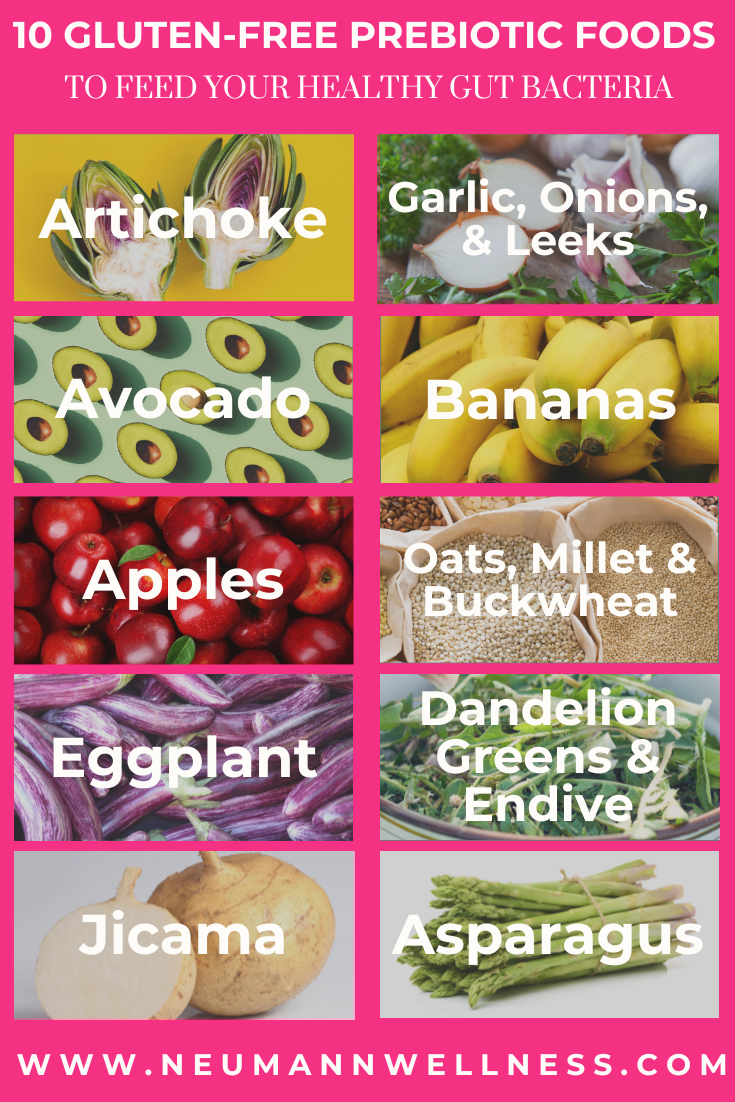
Bonus: Resistant Starch – The Dark Horse of Gut Health
Here’s a little-known gem in the world of prebiotics: Resistant Starch. While it’s not officially classified as a prebiotic, this powerhouse fiber deserves some serious attention. Resistant starch is a non-digestible carb that your gut bacteria love to ferment. The result? Major health benefits for your gut and beyond.
One of the key reasons resistant starch is such a gut hero is because it helps boost the production of Short Chain Fatty Acids (SCFAs). These SCFAs are like rocket fuel for your gut cells (called enterocytes) and they work wonders in reducing overall inflammation in your digestive tract.
So, even though resistant starch isn’t officially on the prebiotic list yet, its ability to fuel your gut microbiome and improve gut health makes it a dark horse you don’t want to overlook.
Top gluten-free resistant starches to add to your diet:
- White & Brown Rice (cooked, then cooled)
- Potatoes (cooked, then cooled)
- GF Oats (cooked, then cooled)
- Beans & Legumes
- Lentils
- Green Bananas
- Plantains
- Potato Starch
- Tiger Nuts
Start adding these foods to your meals slowly, and watch your gut health take off!
How Much Resistant Starch Should You Eat?
If you’re wondering how much resistant starch you should be aiming for, the general recommendation is about 20g per day. Unfortunately, the typical American only gets around 5g a day, so there’s definitely some room to up your intake!
But here’s the thing—if you’re not used to eating much resistant starch, you might want to tread lightly, especially when it comes to beans, legumes, and lentils. These can cause gas and bloating for some folks, so don’t dive in headfirst without caution.
Here’s a trick to make it easier: try Bean Assist—an enzyme that helps reduce the uncomfortable side effects like bloating and gas from beans. It’s clean, free from junky fillers, and skips over the common allergens that could throw your gut off track.
So, start slow, ramp up gradually, and let your gut reap the benefits of more resistant starch!
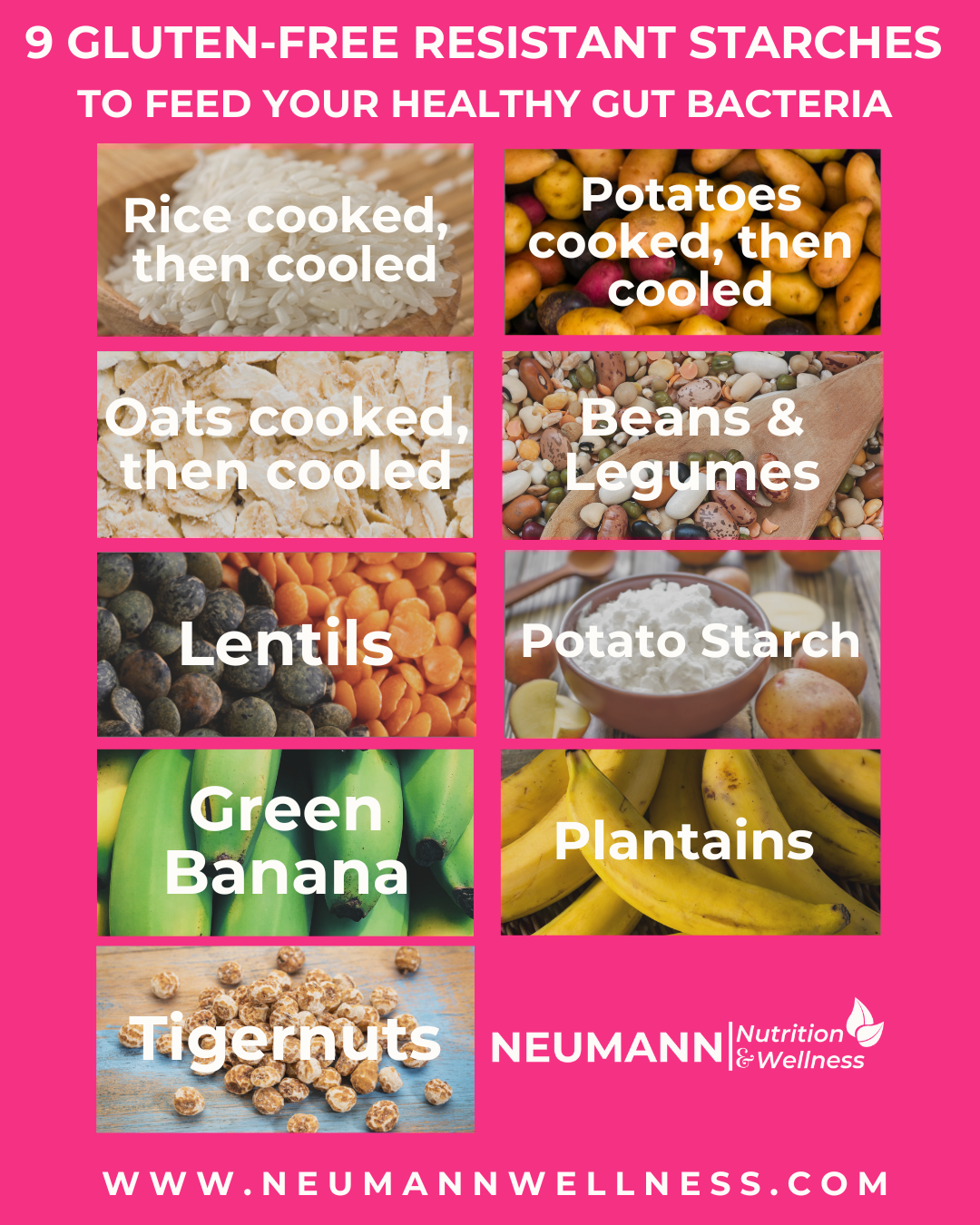
How to Supercharge Your Meals with Prebiotics & Probiotics
Now that you’re armed with some of the best prebiotic foods to boost your gut health, let’s take it a step further. To truly get the most out of your gut-boosting routine, it’s key to combine prebiotics with probiotic foods. When you pair them together, you’re giving your gut the perfect balance of fiber and live beneficial bacteria for optimal gut health.
Here’s where the magic happens: prebiotics feed the probiotics, helping them thrive and do their job even better. So, why not fuel up on both in the same meal?
To kickstart your journey, here are my top 20 prebiotic and probiotic meal & snack ideas to help you balance your gut microbiome and keep things running smoothly:
- Plantain ceviche + gluten-free crackers or chips to dip
- Dandelion greens + kraut + kefir ranch dressing (or Italian dressing with kombucha)
- Regular Yogurt (or homemade coconut or nutmilk yogurt) + seeds + berries
- Smoothie: coconut water kefir + apple + avocado + honey + mint
- Eggplant lasagna
- Endives + miso-tahini dressing + fermented lime-ginger carrots
- Asian bowl with cooked then cooled rice + endive +stir fried veggies + kimchi
- Potato salad with green beans and asparagus
- Green banana flour brownie bites
- Smoothie: slightly unripe banana + frozen berries + 1 tbsp Bob’s Red Mill Potato Starch + coconut water kefir + honey to sweeten
- Cold rice salad with mango and coconut + fermented apple chutney
- Speedy 3 bean salad
- Plantain tortillas + guacamole + shredded chicken + fermented salsa
- Cozy Millet bowl with mushroom gravy & kale (subs corn starch with potato starch)
- Raw buckwheat breakfast porridge
- Hummus + veggies or buckwheat crackers
- 1 pot everyday lentil soup
- Jicama Salad + beet kvass
- Black bean plantain bowl
- Summer Slaw
The Best Prebiotic Supplements
When I see disruptions in a person’s microbiome through comprehensive stool testing, I often recommend prebiotic supplements as part of a clinical strategy to restore balance. These supplements are more potent than food sources alone and can help shift the gut microbiota environment more quickly.
You won’t always see the word “prebiotic” on the label, but you’ll find other terms like:
- Lactulose
- Galactooligosaccharides (GOS)
- Fructooligosaccharides (FOS)
- Xylooligosaccharides (XOS)
- Partially Hydrolyzed Guar Gum (PHGG)
- Galactomannan (Konjac Root)
- Beta-Glucan
- Acacia Fiber
- Human Milk Oligosaccharide (HMO)
These prebiotic forms are powerful tools to help your gut microbes thrive and quickly get your gut back on track. Here are a few of my go-to prebiotic supplements:
SUNFIBER
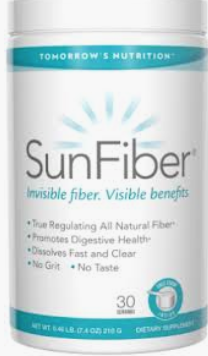
Sunfiber is an excellent tasteless prebiotic you can mix into any hot or cold food or beverage. It’s made from hydrolyzed guar gum and it’s very well tolerated by most. I recommend starting out with just 1/4 of a scoop daily.
BIMUNO
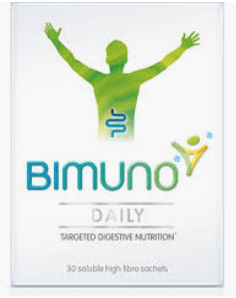
Bimuno is made from GOS and it also mixes well into any food or beverage. I recommend starting out with just 1/4 of a stick of powder daily.
NOW NutraFlora FOS

NutraFlora FOS is a pleasant-tasting natural fiber comprised of concentrated FOS. It has a nice sweet taste. This one is sometimes not as well tolerated by some but still a great option. I recommend starting out with just 1/4 of a teaspoon a day.
In Conclusion
Prebiotics are a game-changer when it comes to gut health, and as you’ve learned, gut health impacts so many aspects of your well-being—digestive issues, autoimmune conditions, eczema, mental health, hormones, obesity, and more.
By fueling the growth of beneficial gut microbes and keeping harmful ones in check, prebiotics do wonders for our health.
To reap the benefits, aim for at least 5g of prebiotics per day, with up to 20g coming from prebiotic-rich foods. Don’t forget to include resistant starches for extra gut perks!
The best approach is to get your prebiotics from whole foods, ideally paired with probiotics. But if you need a quick fix, prebiotic supplements can definitely help boost your gut health on the fly.
Here’s the Best Part: I’ve Got Your Back in Finding Your Way to True Vitality
No more guessing games, no more randomly eliminating foods and hoping for a miracle.
I’m here to help you design a clear, customized path to wellness that’s built specifically for your body. We’ll pinpoint the exact foods causing your gut issues, then work together to create a plan that heals and restores balance. This isn’t a one-size-fits-all approach—it’s a solution tailored to you.
Ready to uncover the true cause of your gut inflammation and start your transformational gut healing journey? My program is custom-built and reserved only for those who’re ready to go all in. Schedule your digestive assessment with me to get started.
References:
https://www.ncbi.nlm.nih.gov/pmc/articles/PMC3705355/
https://onlinelibrary.wiley.com/doi/full/10.1111/1541-4337.12119
https://www.ncbi.nlm.nih.gov/pmc/articles/PMC6041804/
https://jn.nutrition.org/article/S0022-3166(22)02820-6/fulltext
https://www.sciencedirect.com/science/article/abs/pii/S2214799322001618
https://onlinelibrary.wiley.com/doi/pdf/10.1111/nbu.12244
https://pmc.ncbi.nlm.nih.gov/articles/PMC8970830
https://pmc.ncbi.nlm.nih.gov/articles/PMC7231265
https://www.sciencedirect.com/science/article/abs/pii/S0926669023000821
https://pmc.ncbi.nlm.nih.gov/articles/PMC3823506
https://pmc.ncbi.nlm.nih.gov/articles/PMC5490512
https://pmc.ncbi.nlm.nih.gov/articles/PMC11167165
https://pmc.ncbi.nlm.nih.gov/articles/PMC9104503

